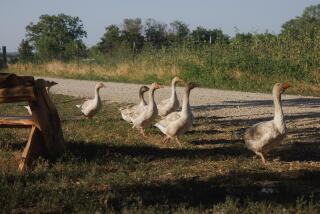Trees From the Philippines Help Provide a Sliver of Hope for Hardscrabble Farms : Haiti: Soil that almost literally sprouts rocks is being reclaimed with a few simple techniques.
- Share via
PASSE CATABOIS, Haiti — In this most impoverished region of the poorest country in the Western hemisphere, the land grows rocks. They emerge each growing season like fields of petrified potatoes, as wind and rain sweep topsoil into the sea.
There is little that is green here. Vast areas of Haiti look almost as if armies of carpenter ants have chewed through the land, devouring every living stand of wood. Almost totally forested with mahogany and oak just two centuries ago, the entire country is now virtually barren.
“Eighty percent of the land area of Haiti is no longer suitable for the cultivation of crops,” said an official of the U.S. Agency for International Development in Port-au-Prince.
This devastating erosion of soil that was once among the world’s richest has passed the point of no return in much of Haiti, especially here in the Northwest province, according to soil conservationists and agronomists. It cannot be restored.
“You can’t just throw money at it and put it back on the hillsides,” said Peter Welle, an agro-forestry specialist from southern Illinois who leads an ambitious agricultural recovery program here for CARE. “A watershed lost is lost forever, and forever is a long time.”
In the face of this accelerating environmental catastrophe, thousands of poor Haitians have simply given up and risked their lives in a desperate gamble that they can reach Florida, packed like straws in a box in leaky, overcrowded sailboats, and start anew. Many die. Most are caught and turned back by the U.S. Coast Guard.
But as woeful as their lives are, there remains at least a sliver of hope for the majority who stay behind.
While the thin layer of crumbly dirt on which the 60,000 farmers of Haiti’s Northwest province scratch out an ever-diminishing, bare-survival diet cannot be replenished, it can be saved before it washes down to bedrock, said Welle. And that is what CARE is trying to help the farmers do.
The dust-dry, silty clay loam of the hillsides can even be made to produce as much as 50% more and better crops, if the farmers adopt a few simple soil and water conservation techniques that have wrought near miracles in even bleaker settings such as desert-bound Niger and Chad, said CARE Haiti Director Virginia Ubik.
At the heart of the CARE program, targeted at 30,000 mostly undernourished farmers in these bleak hills, stand trees, millions of them, and not your ordinary back yard varieties.
During a punishing, recent jaunt through the mostly road-less region, Welle and Ubik pointed out scores of hardscrabble farms that in little more than a year have been transformed from vanishing silt into tillable ground by lines of thrusting tree seedlings holding back stadium-like terraced rows of precious soil.
Last year, CARE distributed 2.3 million seedlings, many of them exotic multipurpose varieties from Asia. By the end of CARE’s 10-year Farmers’ Resources Management (FARM) project here, there will be 30 million seedlings, and hundreds of farmer-managed small nurseries will be growing millions more.
Already small trees are everywhere. They guard rock walls, hedgerows and dry debris barriers that define the terraces; they plug gullies through which earth might escape in a torrent. Or they are just scattered in the fields for a variety of uses.
One in five are a variety called neem, a tree from the Philippines that is a virtual farmyard cornucopia wherever it grows. Neem leaves, rich in nutrients, are commonly called “green manure” when tilled into the soil. The seeds--each tree drops about 70 pounds a year--can be ground and mixed with water to make a safe, effective organic insecticide, while the chaff can be used to suppress malarial fever.
To grow more neems one has only to lop off a branch and stick it in the ground. It soon sprouts, even in Haiti’s wretched soil.
More important, neem and nine other species distributed from CARE’s multiplying nurseries in the northwest region can be cut back to bare stumps for cooking fires and charcoal, and within three to four years, they will regrow to be harvested again and again. In that sense, neem is a renewable, cash crop.
That is important because charcoal, Haiti’s principal fuel, is one of the prime villains in a devastating cycle of environmental degradation, said Maureen Plas, another of the handful of Americans who are gradually turning over management of the FARM project to Haitians they have trained. Plas described the cycle like this: As trees are cleared to make charcoal, land erodes and crops diminish, forcing farmers to make up for the crop loss by cutting down ever more soil-holding foliage to make and sell more charcoal.
In the Northwest province, charcoal-makers are now down to mesquite as a source of wood, and along the coast they are chopping into the mangrove swamps where fish and birds breed.
Baring the earth also disrupts rainfall patterns and watersheds, she said, adding drought to the farmers’ ills.
“Its gotten so dry farmers have been scooping out stumps to make charcoal,” said Welle, ruefully recalling two years of low rainfall in the region.
But because there is no substitute for charcoal, the cycle can be broken only by growing renewable crops of trees, such as neems, which not only hold the soil but do not have to be uprooted to feed the unquenchable need for fuel.
Understandably then, some of CARE’s most ardent advocates are the charcoal merchants, such as Syfida Joseph, 33, who supports a burgeoning family in the market town of Bassin Bleu by buying charcoal from farmers and shipping it to the cities at a profit of about 80 U.S. cents per man-sized bag. Each bag represents the remains of as many as 10 trees, she said.
“I preach to the people, you got to plant trees,” she said, “and I plant trees.”
So does Similien Sime, 36, a houngan (voodoo priest) who travels widely around the area performing ceremonies for ill and troubled people. “The water in the sky is less now,” he said, rolling his eyes upward, “and we need to pray more.” But he added that farmers are learning so much about soil and water conservation and tree-planting from CARE-trained Haitian field agents that “I don’t have to preach agriculture any more.”
So far, CARE has trained more than 100 field agents, each of whom reaches out to about 60 farmers, demonstrating the intricacies of proper terracing for soil and water conservation and helping them to get simple agricultural tools, seeds for planting and tree seedlings. By 1999, Welle said, 30,000 farmers representing 150,000 family members will have been trained in up-to-date but relatively simple conservation measures.
“The main objective is to develop a critical mass of farmers who have practiced these techniques, incorporated them into the system and seen the economic benefit,” said an official of USAID, which is funding much of the CARE program. “Their neighbors will see it and pick it up. Their sons will farm that way also. That’s the goal.”
Welle said he is confident the project will succeed.
“Farmers are not stupid, you know,” he said, recalling his own early life on an Illinois farm whose soil had once been perilously endangered. “When you hear them say they are growing rocks in the garden you know they understand what erosion is.”
More to Read
Sign up for Essential California
The most important California stories and recommendations in your inbox every morning.
You may occasionally receive promotional content from the Los Angeles Times.










